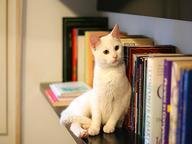Quiz Answer Key and Fun Facts
1. Thomas More was a humanist and a renaissance man, with a keen interest in antiquity. He studied three ancient languages. One of them was the language of More's book 'Utopia'. Another language he studied at Oxford was the language of the author Lucian, whose work More greatly admired. And the third language he studied is very important for understanding the Bible, a crucial book for a religious man like More. Which ancient language however did he NOT study?
2. Thomas More befriended many great minds of the humanist era. One of them was a Dutchman from Rotterdam. More considered his first encounter with this man (in London, in 1499) "a pivotal moment in his life". Who was this man?
3. Erasmus wrote a book in honor of his fried More. The Latin title of this famous work ('Laus stultitiae') is not as witty as the Greek one ('Enkomion Morias'), the latter being a reference to Thomas More. What's the English title?
4. Thomas More was emprisoned in the Tower by king Henry VIII. While in prison, he wrote 'De tristitia Christi', 'On the Agony of Christ'. Finally, in 1535, More was beheaded. All this because More, as a devout catholic, objected to the divorce of Henry and his first wife (1533). Who was she?
5. Thomas More wrote much more than his famous 'Utopia'. Between 1513 and 1518 he wrote "about the lyfe" of an English king. More's account was popular and influenced authors such as Shakespeare. The work survives in English and Latin versions, both unfinished, with some variation in detail between the two. About which "kyng" did both More and Shakespeare write?
6. What would be a good translation of the title 'Utopia'?
7. 'Utopia' mainly tells the travels of Raphael Hythlodaeus, a merchant More claims to have met in a Flemish city on the Scheldt, where he saw the man after a mass in Our Lady's Cathedral. What city would that be?
8. Although Raphael Hythlodaeus is fictitious, this character claims to have been a companion of a real explorer. That Italian explorer made several voyages to the New World, mostly to Brazil, and died in 1512, shortly before 'Utopia' was published. Who was he?
9. 'Utopia' is a satirical work about More's own time, but it is also a philosphical treatise about an ideal state. In writing this book, More clearly pays homage to an ancient Greek philosopher. Who was that author of 'The Laws' and 'The Republic'?
10. The courage with which More maintained his religious convictions, and his dignity during his imprisonment and execution, contributed much to More's posthumous reputation. His friend Erasmus defended More's character as "more pure than any snow". And many religious and philosophical leaders were heavily influenced by his ideas. Which movement did NOT find a source of inspiration in More's writings?
Source: Author
muivers
This quiz was reviewed by FunTrivia editor
looney_tunes before going online.
Any errors found in FunTrivia content are routinely corrected through our feedback system.
